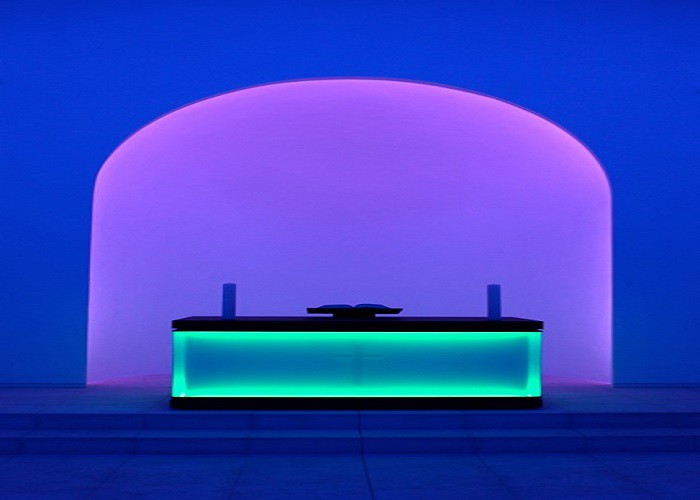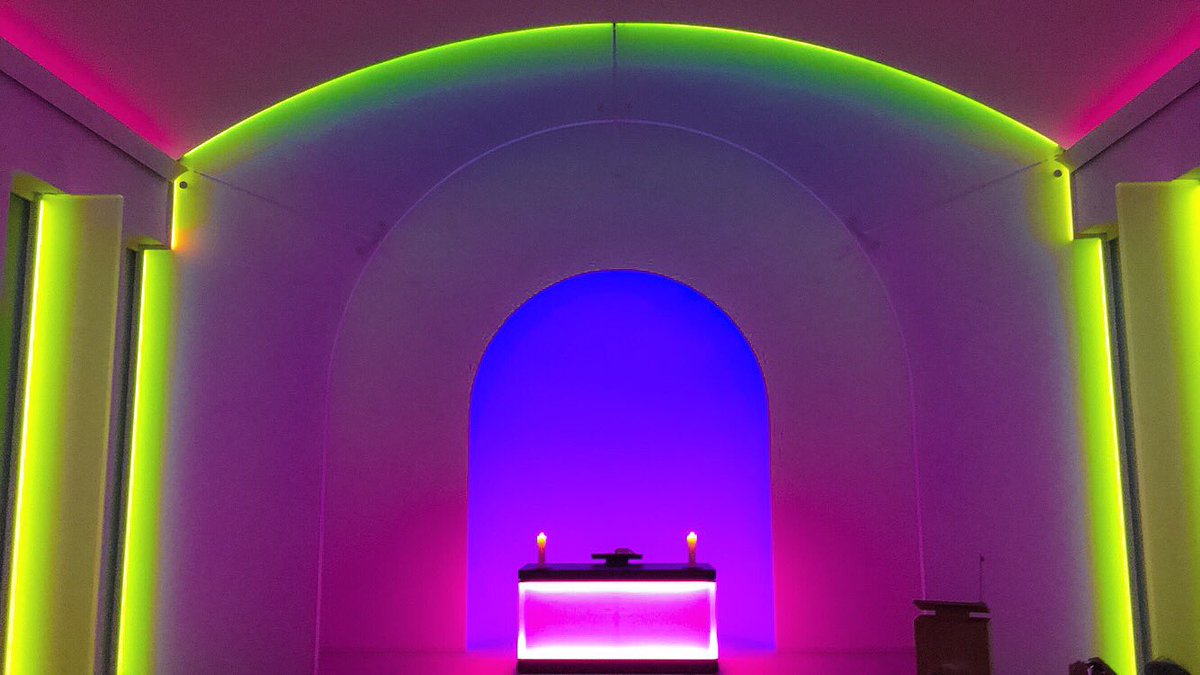December 5: Light of the World
♫ Music:
LIGHT OF THE WORLD
Scripture: John 8:12
Again Jesus spoke to them, saying, “I am the light of the world. Whoever follows me will not walk in darkness, but will have the light of life.”
Song to the Creator
by Hildegard of Bingen
You, all-accomplishing
Word of the Father
are the light of primordial
daybreak over the spheres.
You, the foreknowing
mind of divinity,
foresaw all your works
as you willed them,
your prescience hidden
in the heart of your power,
your power like a wheel around the world,
whose circling never began
and never slides to an end.
ANOTHER LIGHT
Human eyes are able to perceive only a tiny percentage of the light in the cosmos. The electromagnetic spectrum includes wavelengths of light ranging from thousands of kilometers long down to atomic fractions, within which humans see only wavelengths of roughly 390 to 700 nanometers. This narrow spectrum accounts for all the richness and astonishing variety of colors that humans are physiologically capable of seeing—beyond this, all wavelengths of light appear to us as utter darkness (ultraviolet, x-rays, and gamma rays have higher frequencies than humans can see, whereas infrared, microwaves, and radio waves have frequencies lower than we can see). In addition to these physiological limits, human vision is also limited by, and incredibly variable within, changing light contexts: as our eyes constantly readjust to the visible light available in any given situation, so too do our perceptions of color and form.
The famous light-and-space artist James Turrell explores these perceptual limits. His renowned Skyspaces, for instance, use intensely saturated light to change the color context in which viewers see the sky (particularly during the liminal periods of dawn and dusk), causing the same sky color to appear alternatively light or dark, warm or cool. For many viewers, these experiences are not only optical; they also have spiritual and theological implications, which are sometimes made clear by their context: Turrell, who is a Quaker, has installed Skyspaces in two Quaker meetinghouses—Live Oak Friends Meetinghouse in Houston and Chestnut Hill Friends Meetinghouse in Philadelphia—and more recently he created a permanent installation in the memorial chapel of the Dorotheenstadt Cemetery in Berlin (shown here).
The Dorotheenstadt Chapel is designed to let natural light in through narrow, translucent windows along the sides of the chapel and through skylights above the altar. Similar to the Skyspaces, this light is dramatically recontextualized through a one-hour cycle of saturated colors emanating from hidden LED fixtures throughout the chapel. The lighting cycle coincides with the sunset. When the cycle begins, the chapel interior glows with brilliant blues, and the glowing altar begins morphing in color every two minutes. As the sunlight gradually drains from the sky, the interior of the chapel changes from blue to intense greens, reds, and magentas, causing the color of the natural light filtering through the windows to shift in appearance from orange to pink, deep violet, light gray, green, and so on. The waning daylight is manifestly made to appear pale and then black, pink and then green, depending on the vibrant context in which it is seen. As the cycle eventually draws to an end and the sunlight disappears from the sky, the chapel radiates light outward into the otherwise dark cemetery.
The sunset has long held significance in Christian liturgical theology by symbolically associating the setting sun with the end of the present age—an eschatological ending, beyond which begins the seemingly impossible new day: the redemption of all things. And in this symbolism, Christianity has always pressed the question of how the suffering of the present age is to be perceived. Our bodies break down and die and the sun disappears from our horizons—is there another light by which to see our situation? Is there another light that shines in this darkness—perhaps one rising on another historical horizon with a light that our eyes aren’t adjusted to see? The Dorotheenstadt Chapel is situated in a cemetery—a field of buried bodies—and it is precisely here, from inside this ecclesial space, that we are challenged to explore how radically our perception of the waning light of this day might be seen in another light.
Prayer
Almighty God, You make the night shine with the brightness of the true light. Grant that here on earth we may walk in the light of Jesus' presence. And in the last day wake to the brightness of His glory. Through Your only son, Jesus Christ, our Lord, Who lives and reigns with You and the Holy Spirit,One God, now, and forever.
Amen.
Jonathan A. Anderson
Associate Professor of Art
Sunset Memorial Chapel (7 images)
James Turrell
Light installation
Dorotheenstadt Cemetery, Berlin, Germany
About the Artist and Art:
James Turrell (b. 1943) is an American artist primarily concerned with the interplay of light and space. Owing much to the work of Color Field painters such as Mark Rothko, and the expanded definition of art to include light-filled spaces, Turrell’s work is deeply informed by the psychology of perception and how vision intersects with the mind. Over the years, Turrell's work has evolved along with advancements in light-based technology, but it remains focused on the viewer's perception of light within highly controlled environments that must be experienced in person.
A lifelong Quaker, Turrell’s work suggests the notion of light with a decidedly religious connotation. His magnum opus, begun in 1977, is a volcanic crater in central Arizona, replete with apertures and tunnels that will eventually afford viewers glimpses of light from other galaxies.
In his installation for the Sunset Memorial Chapel, Dorotheenstadt Cemetery, Berlin, Germany, Turrell customized the interior architecture to optimize 10 unique light programs. Eight unique programs bathe the space in shades of white light, while the altar is illuminated in different symbolic colors: red for Pentecost, violet for Advent, and white for Christmas and Easter.
http://jamesturrell.com/
Dorotheenstadt Chapel Website:
http://www.evfbs.de/index.php?id=144
About the Music:
“Lux Aurumque” or “Light and Gold”
Lyrics:
Light, light
Light, light
Light, light
Warm
Warm
And heavy
And heavy
And heavy
Pure
Pure
Pure like gold
They sing and sing and sing
To the newborn babe.
About the Composer:
Grammy-winning composer and conductor Eric Whitacre (b. 1970) is one of the most popular musicians of his generation, known for his choral, orchestral and wind ensemble music. He is also known for his "Virtual Choir" projects, bringing individual voices from around the globe together to create online choirs. His concert music has been performed throughout the world by millions of amateur and professional musicians alike, while his ground-breaking “Virtual Choirs” have united singers from over 110 different countries. A graduate of the prestigious Juilliard School of Music, Eric was recently appointed Artist-in-Residence with the Los Angeles Master Chorale having completed a five-year term as Composer-in-Residence at Sidney Sussex College, Cambridge University, UK. Whitacre's music has been described as "softly spoken, deeply harmonic and tuneful, but making use of unusual rhythms and sound balancing to create highly textured music.”
http://ericwhitacre.com/
About the Performers:
Lux Aurumque (Light and Gold) is a choral composition in one movement by Eric Whitacre. It is a Christmas piece based on a Latin poem of the same name, which translates as "Light, warm and heavy as pure gold, and the angels sing softly to the new born baby.” The version for mixed choir is part of Whitacre's project “Virtual Choir.” The “Virtual Choir” video consisted of a mix of individual recordings by 185 singers from 12 countries which caused "a colossal on-line rush of interest" when it was uploaded in 2011. It had been viewed on YouTube more than five million times.
http://ericwhitacre.com/the-virtual-choir
About the Poet:
Hildegard of Bingen (1098–1179) was a German religious teacher, prophetess, and abbess. She was a prolific writer, particularly of musical poetry, and was known for her prophetic visions. She was dedicated by her parents at the age of eight to become a nun as a tithe to the Church. Although Hildegard was plagued by sickness most of her life, her illnesses did not prohibit her from accomplishing astounding things. She was elected as the leader of her religious community in 1136. One of her works as a composer, the Ordo Virtutum, is an early example of liturgical drama, and arguably the oldest surviving morality play. She wrote theological, botanical, and medicinal texts, as well as letters, liturgical songs, and poems, while supervising miniature illuminations in the Rupertsberg Manuscript of her first work, Scivias, a volume that depicts 26 religious visions she experienced.






